Mario Mandzukic has spent the last eight years operating at the highest level in Germany, Spain and Italy for Wolfsburg, Bayern Munich, Atletico Madrid and Juventus, winning one Champions League, five league titles and numerous other cups along the way. He only failed to reach double figures for goals scored in one of those eight campaigns. Yet, in spite of his consistent showings for some of Europe’s most successful clubs, he lacks definition.
When asking what precisely the Croatian forward is, one receives multiple different answers: he is at once a ‘beast’, a ‘gadget player’, a ‘utility attacker’, ‘Mad Max’s Frankenstein experiment’, a ‘shithouse’. The descriptive terms are colourful and different, but common themes do emerge. The general consensus is that the player can perform a number of different roles well, works incredibly hard, possesses an unorthodox style and is unafraid to do the dirty work. In short, don’t try to label him; he, like Thomas Muller, belongs to his own unique club.
We may not be able to state clearly what Mandzukic is, but we can look more deeply at what he does. Here, we at Total Football Analysis do just that, exploring the 32-year-old’s individual strengths, weaknesses and tactical qualities.
A TACTICAL BACKGROUND
Mandzukic was signed by Dinamo Zagreb in 2007 as a replacement for the Arsenal-bound Eduardo da Silva. At that point in time he was renowned in Croatia for his unsophisticated style and direct approach on the pitch, and he was utilised in a variety of different attacking roles. This continued when he moved to Wolfsburg, as he was often used as a winger while Edin Dzeko led the line.
Revered for his fitness and work ethic, he succeeded Dzeko up front when the Bosnian hitman joined Manchester City. Unsurprisingly, his goals total went up in his second season in the Bundesliga, earning him a move to Bayern Munich. However, despite a positive debut campaign, he never quite adapted after the appointment of Pep Guardiola as manager. “Let’s be honest,” he stated in the summer of 2014. “I can’t play to my strengths under Guardiola’s style – no matter how hard I try.”
Later that same summer Mandzukic signed for Atletico Madrid. The move appeared a perfect one on paper as it allowed him to link up with Diego Simeone, a manager who requires his forwards to link play and help out in the team’s defensive organisation and pressing. However, despite winning over the fans and scoring 20 goals in 43 outings, reported attitudinal issues led to his departure after just one year in the Spanish capital.
During his first year with Juventus, Mandzukic acted as a striker within a front two also featuring the more refined Paulo Dybala, but he was once again forced to adapt when the club signed Gonzalo Higuain. Unable to lead the line consistently, he has since appeared most frequently on the left wing or as a second striker. Essentially, he is Juventus’ Swiss Army Man, filling in wherever he may be needed.
His current manager, Massimiliano Allegri, values him greatly. “Mandzukic gives us physicality both defending and attacking,” Allegri said last year. “When we’re under pressure, we rely on him to a degree. He’s an important player.”
Mandzukic may be shifted around at club level, but for Croatia he is the No.1 frontman. He led the line within their 4-5-1 system at this summer’s World Cup, playing a key role as they reached the final. Not only did he score three goals at the tournament, but he once again showcased the mental, physical and tactical capabilities that have enabled him to enjoy a long career at the top level of European football.
HIGH PRESSING INVOLVEMENT
No striker at this year’s World Cup averaged more tackles than Mandzukic, who made two tackles per game. His closest competitors in this particular field were Serbia’s Aleksandar Mitrovic, who averaged 1.7, and Uruguay’s Edinson Cavani, who averaged 1.5. It’s worth noting that Mandzukic’s higher average also came across a larger sample of games – he made six appearances, while Mitrovic and Cavani made three and four respectively.
This statistic offers a glimpse into the type of attacker Mandzukic is, particularly when playing up top on his own. He is defensively active and leads from the front with intelligence, persistence and endurance. Croatia’s success this summer was largely down to their effective pressing game, of which Mandzukic was an important part.
Instigating the press
Operating as the lone striker within Croatia’s system, Mandzukic was often responsible for instigating his team’s pressing. This involved identifying who to press, when to press them, and how to correctly apply pressure depending on the situation.
The ‘who’ was generally the opposition ball-player; the ‘when’ was generally when the opposition passed sideways within their first build-up line. The ‘how’ varied, though it regularly meant using a run or body positioning to take away the opponent’s passing options and force them into wider areas.
An example of this is seen in the below graphic, taken from the defeat to France. Here, Mandzukic identifies Samuel Umtiti as the man to press. He decides to press in this moment as Umtiti is about to receive a pass and does not yet have control of the ball. He uses the time taken for the ball to reach Umtiti to move closer to the centre-back. While moving closer, Mandzukic bends his run so as to eliminate the possibility of a simple return pass to Raphael Varane.
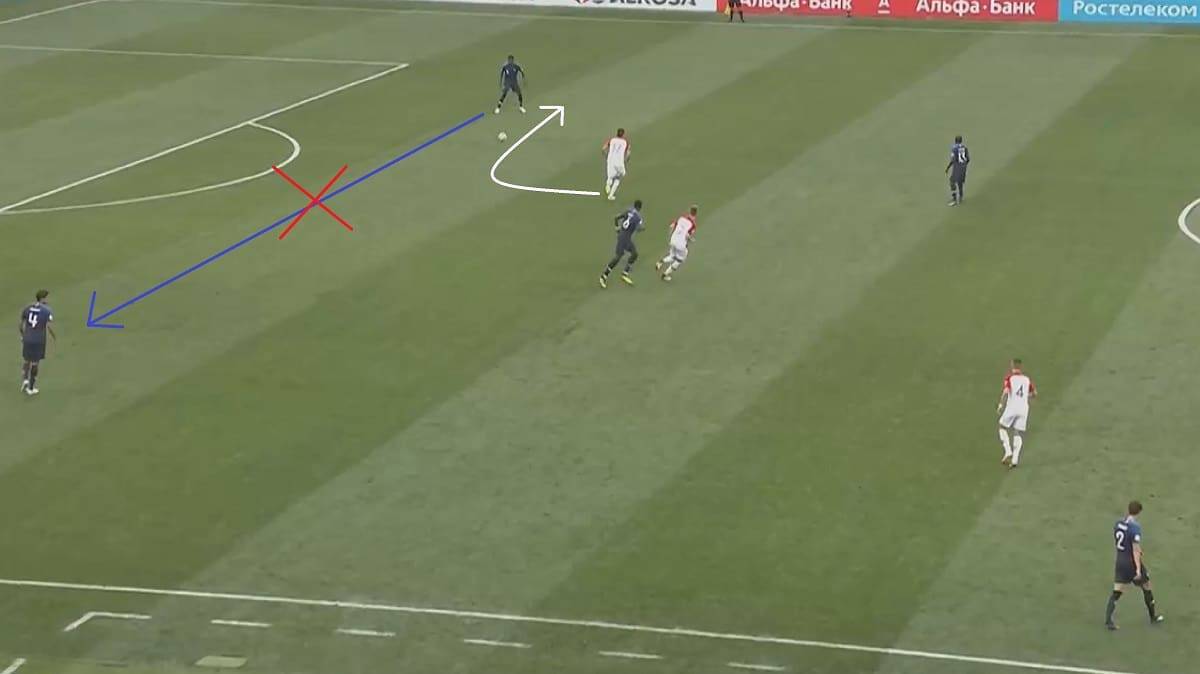
Following through
Most strikers have some involvement in their team’s pressing, though few are as involved as Mandzukic. Unlike many, he doesn’t stop pressing when he has forced his opponent into a certain area. Rather, he follows through.
An example of this can be seen below in a graphic that follows on from the one above. Here, having forced Umtiti wide, Mandzukic continues to remain close and apply pressure to his opposite man, eventually dispossessing him. While the referee, rather harshly, blows for a foul, Mandzukic is successful in disrupting France’s build-up.
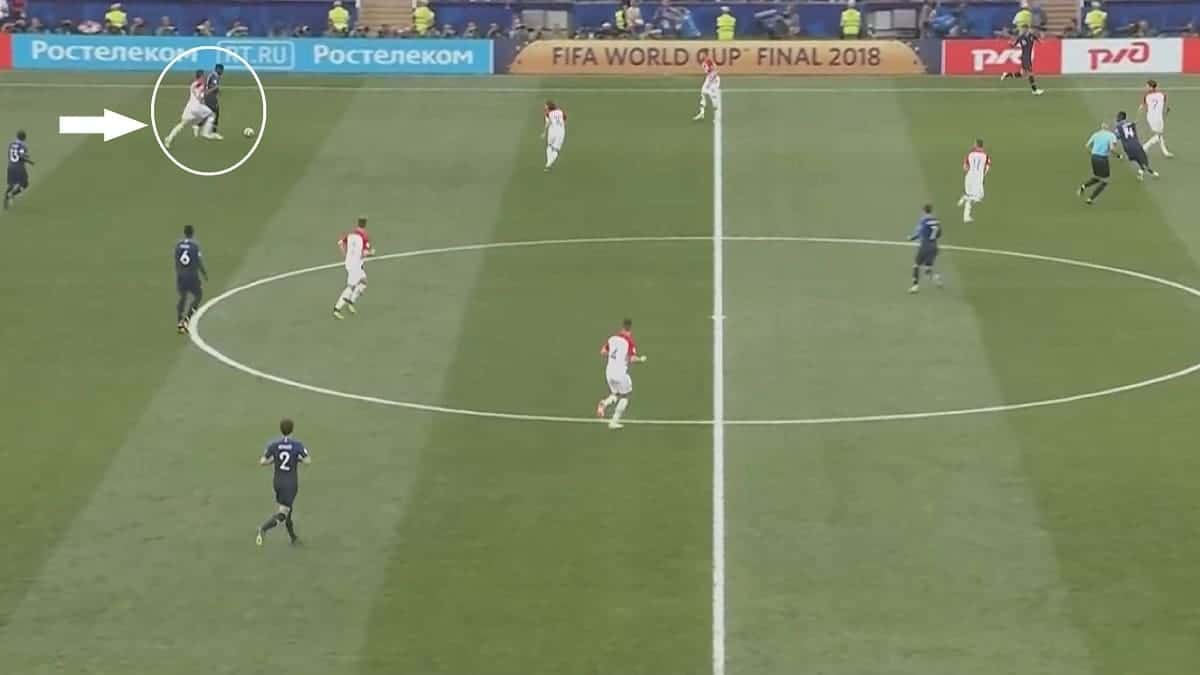
Later on in the same game, Mandzukic would score his third goal of the tournament thanks entirely to his pressing. Following a back-pass from Umtiti to Hugo Lloris, he moved up and continued to press the ball, forcing a mistake from Lloris to score with a tackle.
While some saw the goal as a gift from Lloris, Mandzukic did force the error. Firstly, he followed through to press Lloris when other strikers may have opted not to. Secondly, he altered his run so as to cut off the goalkeeper’s left-hand side. Lloris, who is not comfortable on his right foot, attempted to shift the ball back onto his left, Mandzukic tackled, and the ball hit the net.
Backwards pressing
Mandzukic’s involvement in pressing is unlike many other strikers not only because he ‘follows through’ and continues to press the ball when the opposition pass sideways or backwards, but because he remains engaged even when the opposition have actually bypassed him. In such situations, Mandzukic continues to apply pressure from behind. This ‘backwards’ pressing, seen from him below in Croatia’s World Cup quarter-final win over Russia, is beneficial in a few ways.
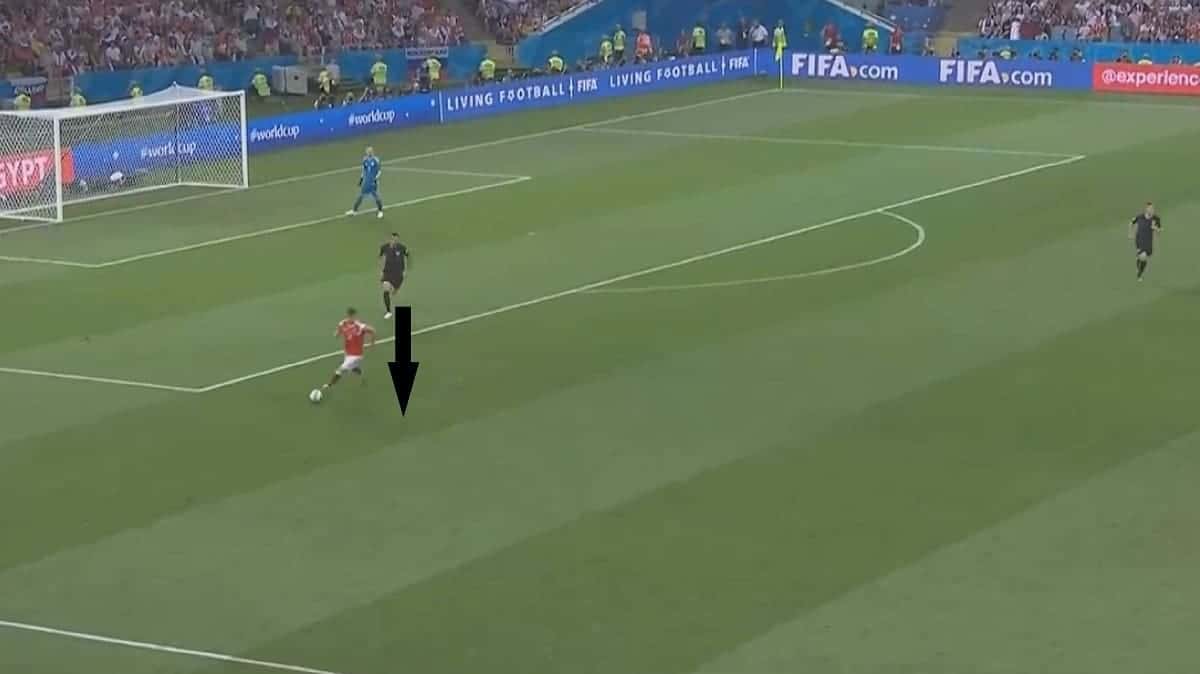
Firstly, Mandzukic’s backwards pressing forces the opponent not to slow down, and can make them panic. They cannot relax in possession, as that would lead to them being dispossessed from behind, so they must maintain or increase their pace while running forward towards a congested area. This increases the possibility of a mistake from the opponent.
Secondly, the backwards pressing reduces the opponent’s scope for passing and dribbling. They are not able to turn back as Mandzukic is right behind them, and sideways passes are also risky as Mandzukic could intercept them. Therefore, the only safe direction for passing is forwards where, as discussed, there is greater congestion.
Finally, the backwards pressing can be used to create a pincer movement where the opponent is pressured from both in front and behind. With Mandzukic breathing down their neck and a group of Croatian midfielders stepping up to press them, the opponent’s space and time on the ball is reduced from two directions. This increases the chance Mandzukic and co. have of intercepting or tackling the opponent.
DEFENSIVE VERSATILITY
Mandzukic can enhance his team’s pressing game, as seen this summer with Croatia. However, he is equally adept when playing for less active pressing sides. As well as making life uncomfortable for the opponent through pressing, he is a team player who is willing and able to retain his position when necessary.
This aspect of his defensive play is on show regularly for Juventus, where he often takes up a more withdrawn role. Last season he appeared predominantly on the left wing and therefore he had to keep his position to ensure the team’s overall defensive shape retained some semblance of compactness. He was also at times tasked with tracking the runs of the opposition full-back, meaning he occasionally took up extremely deep defensive positions, seen below, to maintain access to his opposite man.
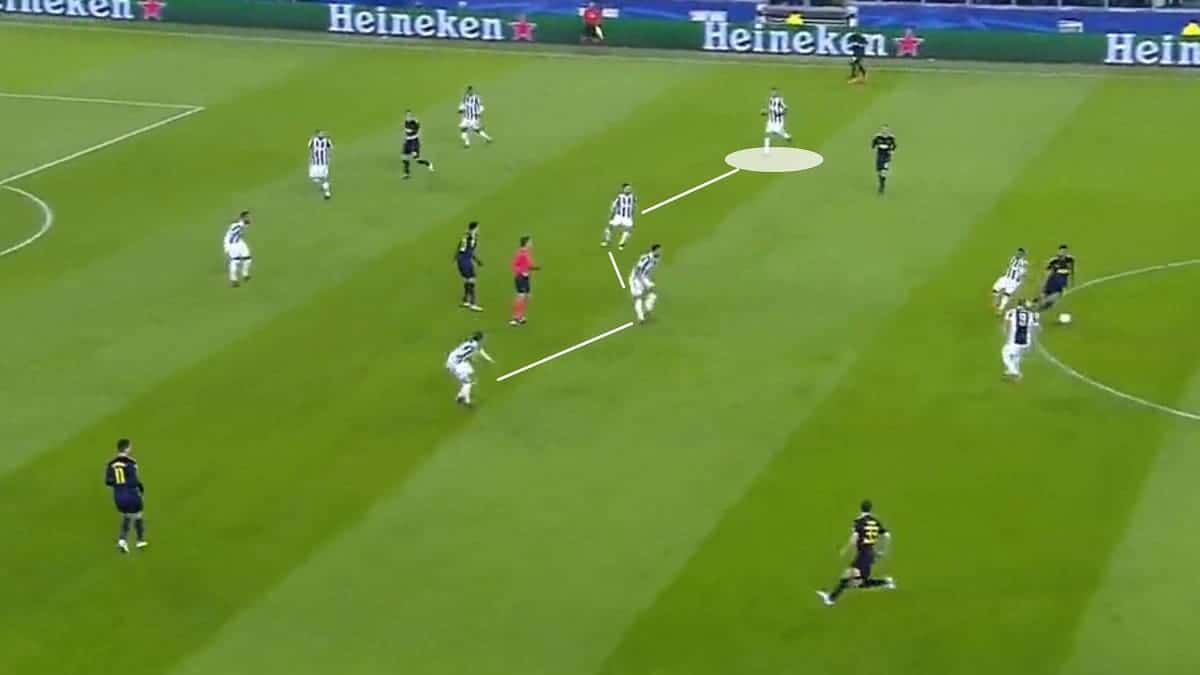
Mandzukic is an extremely dedicated and proactive pressing forward, but he is also able to show restraint. His ability to play effectively in such glaringly different defensive styles is an example not only of his versatility but of his selflessness.
KICK-STARTING THE COUNTER
During this summer’s World Cup, having won or helped to win the ball back in pressing, Mandzukic often found himself on or near the ball in attacking transitions. He was, therefore, responsible for starting the counter-attack. He did this primarily by keeping things simple.
When he wins the ball back off the opposition, he tends to find his nearest available teammate with an easy short pass. Recognising that he doesn’t have a great view of the game unfolding due to his just having tackled an opponent, he prioritises retention of possession before looking to make forward runs to receive the return pass or attack the opposition penalty box.
If, however, someone else wins the ball back, Mandzukic likes to move closer to his teammate to offer them a simple pass. He can then turn and run at a retreating opposition defence or, if under pressure, simply perform a 1-2 with his teammate. An example of this is seen below, where he drifts close to his Croatian teammate to offer a pass before instantly returning them the ball. In the process he drags his marker with him and creates space behind for Croatia to exploit.
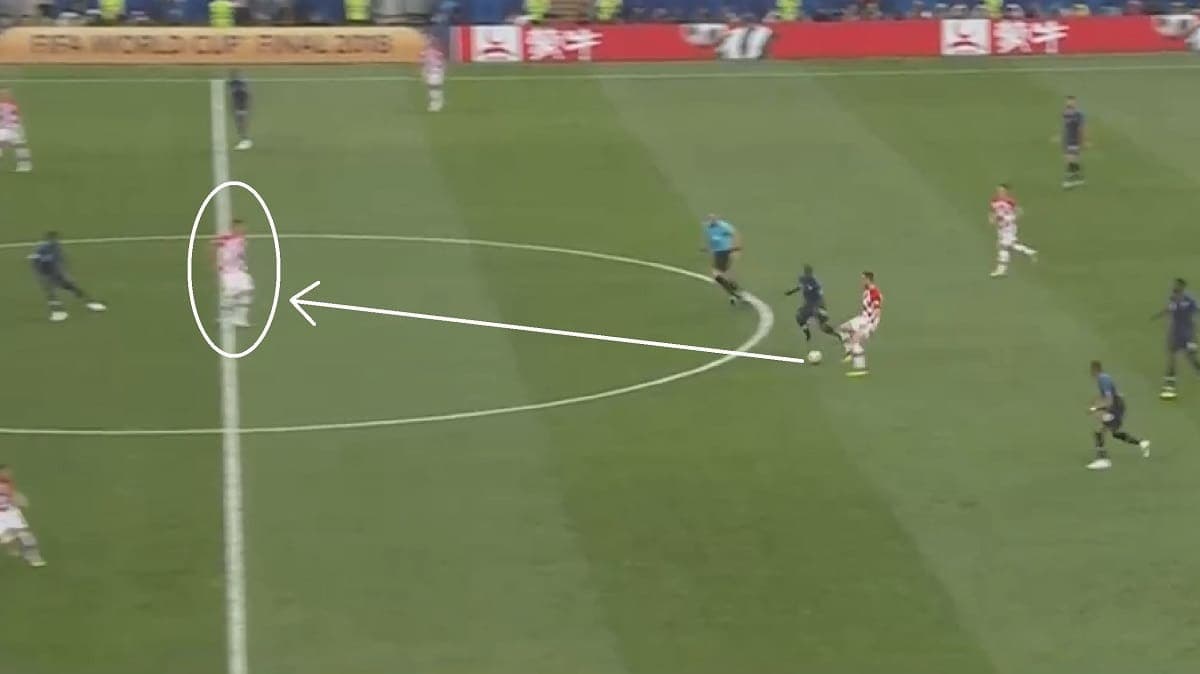
KNITTING ATTACKS TOGETHER
Mandzukic doesn’t look anything like a top-level attacker. He is gangly, awkward and ungainly, on and off the ball. His passing and finishing are far from ‘clean’ and his scoring rate is much closer to one goal every three games than one in one, but he has nonetheless been utilised effectively by some of the world’s best coaches, those who see what most others cannot or do not.
Understanding Mandzukic defensively is fairly easy – he’s often at the forefront in his team’s pressing, after all. However, understanding him in an offensive sense requires more attention to detail. It’s easy to shrug off his touches, passes and finishes as the luck of an average player in a top team, but the reality is more complex.
He isn’t prolific, and you wouldn’t teach a child to learn to pass or dribble by showing them a highlight reel of Mandzukic in action, however these technical deficiencies are more than made up for by the player’s tactical, mental and physical abilities, all of which are used to help knit attacks together in various different ways.
- Offering an out ball
During his usage as a left winger by Juventus in the last two seasons, Mandzukic has often been the focal point for diagonal switches of play through lofted balls over the top of defenders. In these situations, where he is often isolated 1v1 against a defender, he uses his frame to win aerial balls or hold the ball up.
He, therefore, gives his team the option of overloading one side to then quickly exploit the less congested other side. Additionally, his first-time headers across goal can be problematic for an opposition who must adjust twice in quick succession – firstly to deal with the switch; secondly to deal with the ball headed into another area.
As well as offering an outlet for switches of play, Mandzukic acts as an out ball when his team are under pressure. If Juventus or Croatia find themselves losing control of possession due to the opposition’s pressing, they have the option of going from back to front more directly thanks not only to his heading and hold-up play but his willingness to chase down loose balls.
Aerial ability
While he is not a physical powerhouse, Mandzukic stands tall at 6ft 3in and knows how to use every inch of his body to his own advantage. Whether isolated 1v1 as he often is at Juventus or in more crowded central areas for Croatia, he is able to win headers consistently through good positioning, anticipation, and holding off his marker.
Statistics back up his aerial dominance. Last season, only five Serie A attackers won more aerial duels per 90 minutes than Mandzukic’s 3.19. Of those five players, only one – Roma’s Dzeko – won a higher percentage of their total aerial duels than Mandzukic’s 61 per cent. Going direct in attack is not always seen as an efficient strategy for building sustainable possession, but with Mandzukic up front there’s a good chance of the ball sticking.
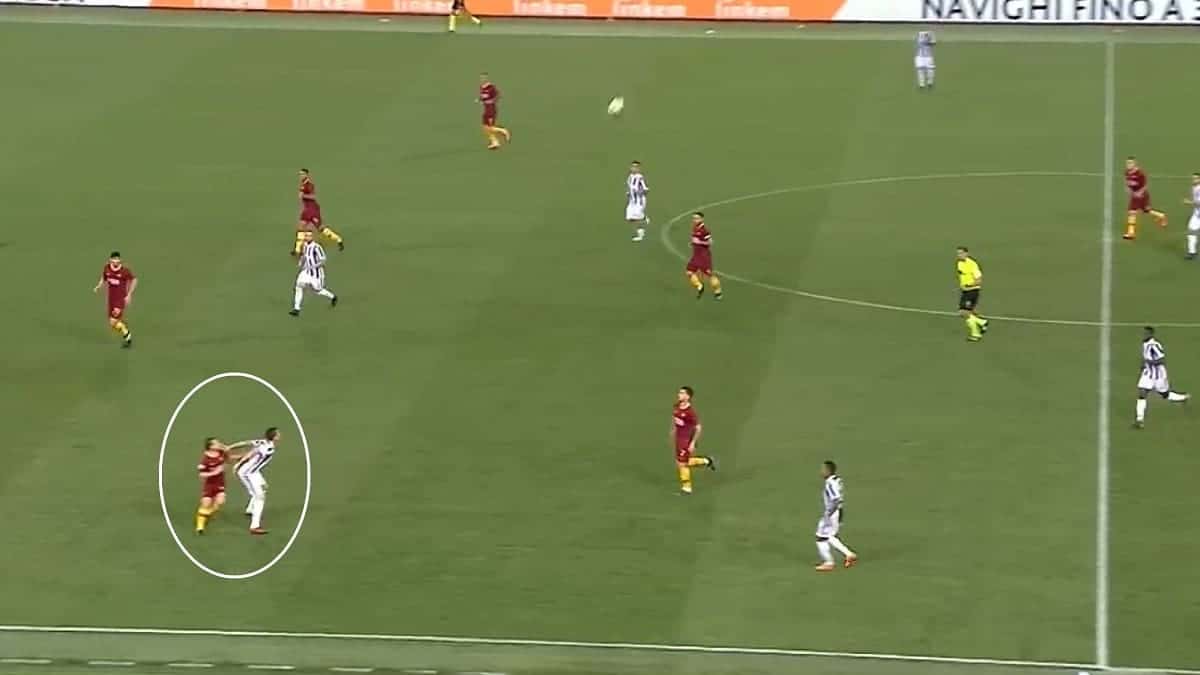
All of what makes the Croatian such an effective aerial target can be seen in the above graphic, taken from Juventus versus Roma last season. To start with, Mandzukic positions himself well to receive the long ball. He then sticks out his backside, meaning his marker will likely foul him if attempting to out-jump him. From there he uses his arms both to gauge where his marker is and to hold off said marker. Thanks to his use of his body, Mandzukic is able to win this particular aerial duel – as he is most aerial duels – without even leaving the ground.
Playing with his back to goal
Whether leading the line on his own, up front as part of a two, or operating out on the wing, Mandzukic spends a large proportion of his time on the pitch with his back to goal. Sometimes he is used simply as a target man for direct attacks, but mostly he is deployed in this way to hold the ball up and lay off to teammates.
He is intelligent when facing away from goal, scanning the pitch to gain awareness of his teammates’ positions and to get a good mental picture of everything that is going on around him. This helps him to form a good tactical understanding of the game as it happens, giving purpose to first-time passes and no-look flicks that would otherwise seem dangerously nonchalant.
The below graphic, taken from Croatia’s World Cup semi-final win over England, offers a good example of this. Here, Mandzukic drifts wide to receive a pass down the wing. He has his back to goal, but a quick scan of the pitch allows him to get a picture of the spaces and positions taken up around him. With this look he notices Ante Rebic making a run inside him. So, while the obvious decision is to control the ball, turn and run at his opposite man, Mandzukic instead opts for a flicked between-the-legs pass into the space behind his marker for Rebic to run on to.
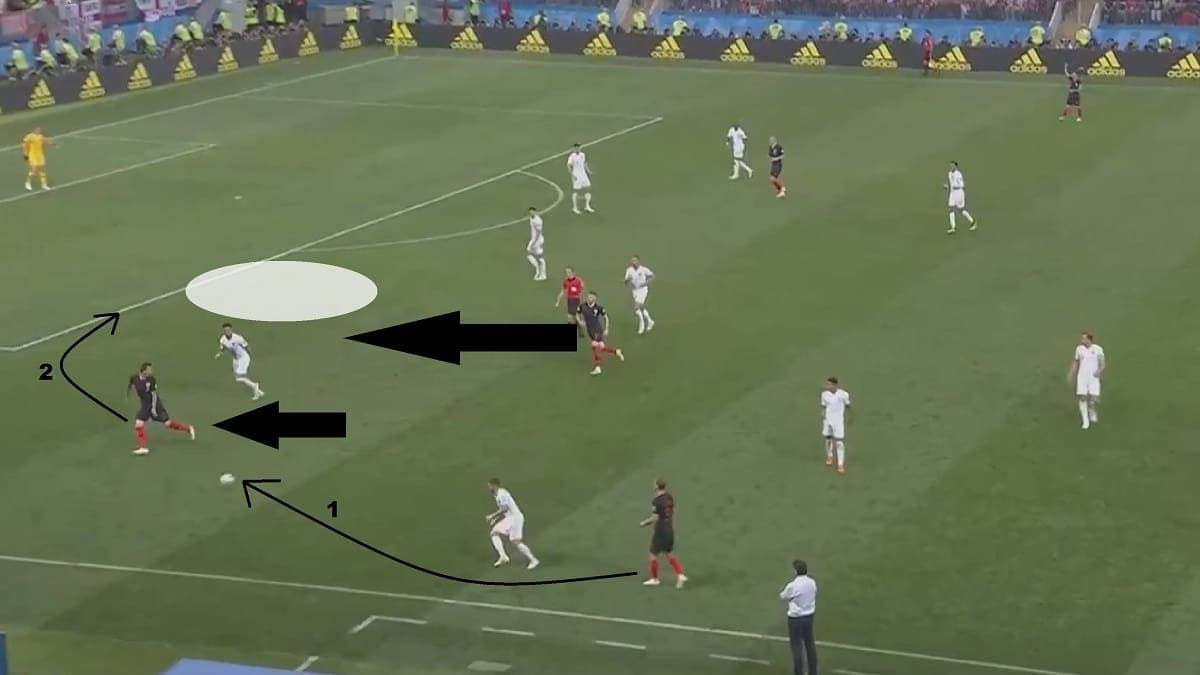
Fluid focal point
Through his aerial ability, hold-up and link-up play, Mandzukic is an effective focal point for progressing attacks. However, he is also a fluid focal point. Rather than remaining static, he moves laterally and vertically to occupy dangerous spaces and connect attacking moves.
Not only does his movement allow him to open up a viable forward passing lane to his teammates, but it makes him difficult to mark. By varying his position and wandering constantly he is able to keep opponents unsure as to who should track him.
As seen below, his movement allows him to evade marking, as France’s defenders decide to sit back rather than go with him. This opens up a simple but penetrative forward pass for Luka Modric to play. Mandzukic receives this pass before finding a teammate, progressing the attack into a more advanced area. Had one of France’s defenders gone with him in this situation, space would have been opened up centrally or on the French defensive line for Croatia to attack.

HOW MANDZUKIC SCORES
Mandzukic is heavily involved in build-up, but he also offers a threat in and around the opposition penalty area. Primarily, he is a genuine aerial danger from crosses, using his height to get on the end of balls into the box. However, he is also able to score with both feet thanks mainly to an incredible poacher’s instinct.
This instinct was on show throughout the World Cup and was integral to two of Mandzukic’s three goals in the tournament. His first goal of the competition, against Denmark, came after a failed opposition clearance deflected to him in the box. After the initial attack had ended, he remained alert and was appropriately positioned to finish from close range.
A similar situation led to his second goal, in the semi-final win over England, as shown below. Here, Ivan Perisic goes up for a header after England clear a Croatia cross. Mandzukic, anticipating his teammate winning the header, makes a run on the blind side of John Stones to latch onto the ball and finish from close range. Like a lot of the Juventus man’s goals, it involved little by way of dribbling, combination play or precise finishing. All it took was intuition and a well-timed run.
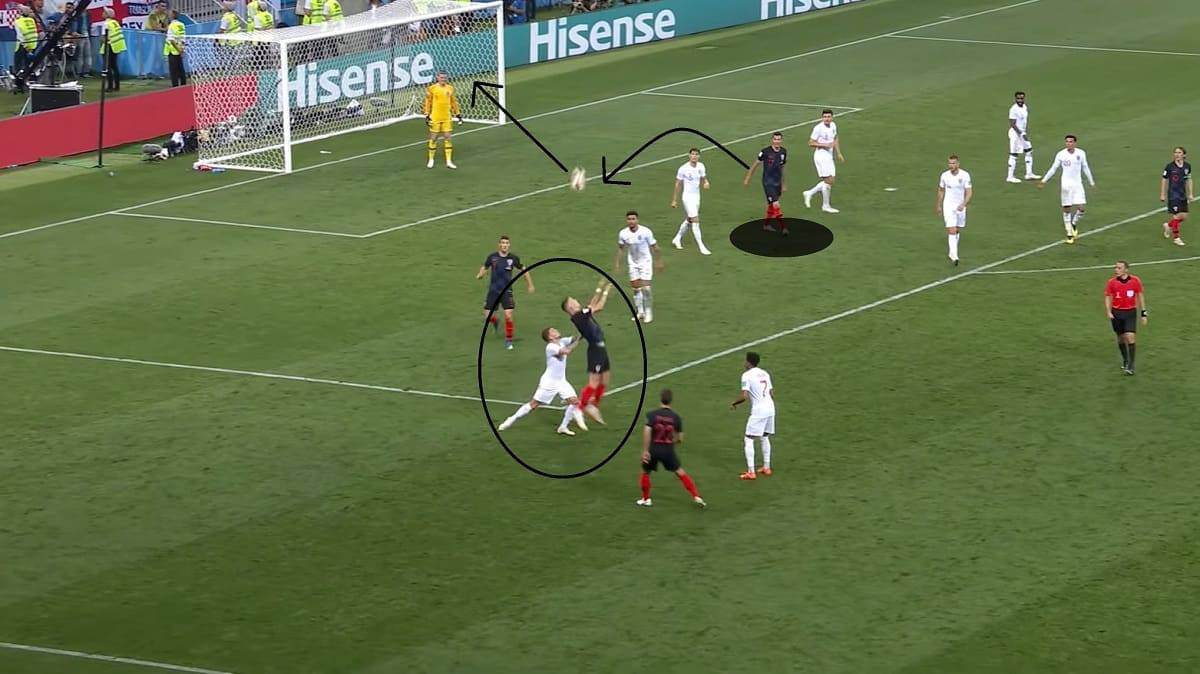
As the above depicts, Mandzukic is an opportunistic forward whose goals are more about the mental than the physical or the technical. He comes alive in the opposition box, demonstrating quick reactions to loose balls and opposing defensive errors, as well as a willingness, if and when necessary, to put his body on the line. His predatory approach to finishing is hinted at by the fact that, last term, just over 82 per cent of his 45 Serie A shots came from inside the penalty area.
WHAT DOES THE FUTURE HOLD?
As discussed earlier, Mandzukic has regularly adjusted his position or simply moved on when more traditional and productive strikers are signed by his club. With this in mind, it’s worth noting there is no guarantee that he will even play for Juventus next season, let alone start, due to their signature of Cristiano Ronaldo.
Ronaldo is likely to lead the line for Juve just as he did for Real Madrid. That, along with the presence of Higuain and Dybala, makes it difficult to see where Mandzukic fits in, even if Allegri loves his versatility and attitude. So, at 32 years of age, where could he go next?
Despite the fact he is likely past his prime, he would make a good addition for a number of clubs. Liverpool’s intense pressing approach would suit him well, and he would offer Jurgen Klopp an aerial alternative to the more skilful Roberto Firmino. He has been linked to Borussia Dortmund recently, and his defensive work ethic would suit Lucien Favre’s approach without the ball. And it would not be wise to completely rule out a return to Bayern Munich, where he could help implement a more bullish, direct style of play under new head coach Niko Kovac.
Whether he stays in Italy or moves on to pursue regular game time elsewhere, Mandzukic cannot be written off. Football’s Swiss Army Man has always relied more on brain than brawn, and that should allow him to continue playing at the top level of European football for some time yet.

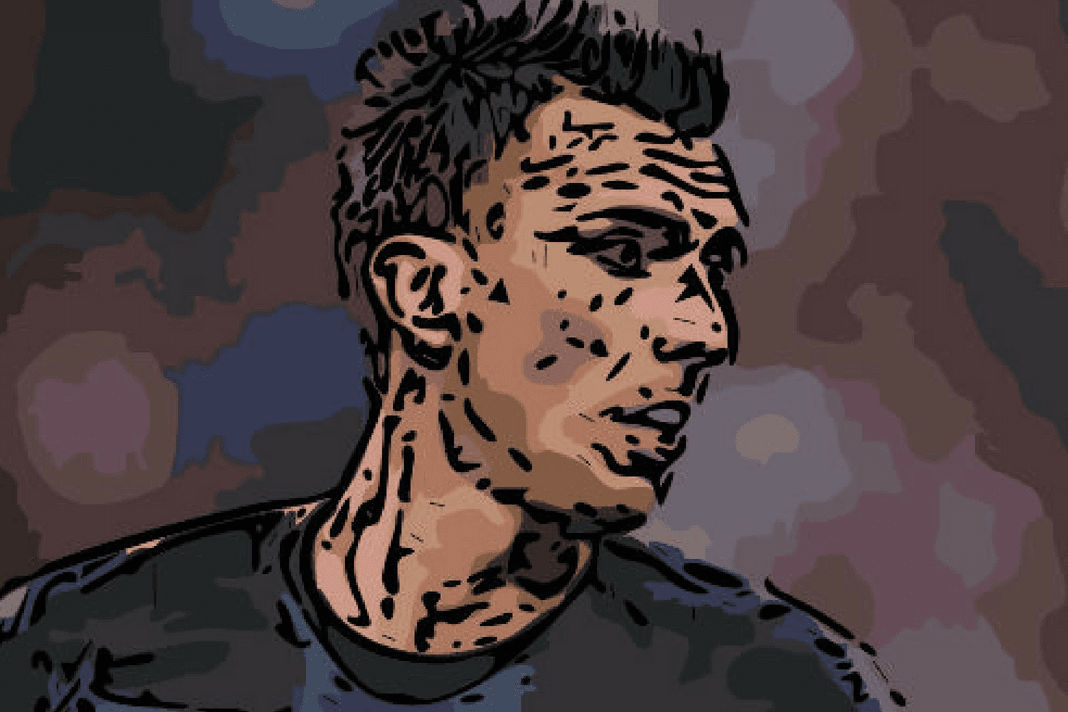




Comments